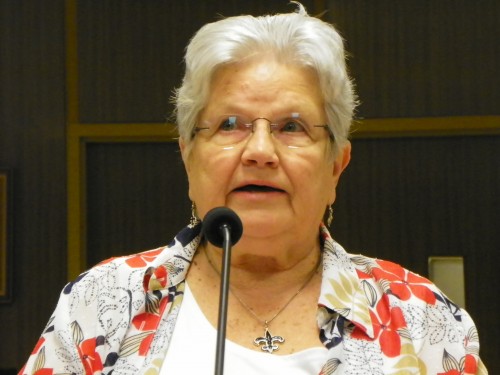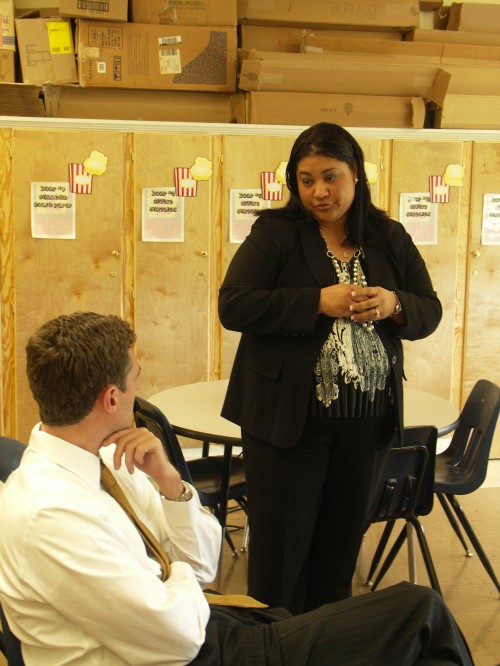
St. Mary elderly program may lose state funding
February 14, 2012Danos joins Duplantis Design Group
February 14, 2012“I really can’t answer how he picked Greenwood or how he picked Terrebonne Parish, but he specifically asked for this school,” Terrebonne Parish School District Superintendent Philip Martin said as he anticipated the arrival of newly appointed Louisiana Superintendent of Schools John White at the Gibson middle school.
Greenwood Middle School Principal Margaret Cage would not admit it directly, but suggested she had a pretty good idea why the school she has led into what is now her second year – she was previously master teacher at the school for two years – caught the state’s top education administrator’s attention.
“It’s because this school has made progress, at the same time it has a way to go,” White explained.
Cage credited determination, a dedicated staff and a specific game plan for closing achievement gaps for the rapid progress.
By collecting data, making a comparative analysis of students and teachers, and changing the classroom structure, Cage helped save the school, labeled as 77 percent disadvantaged and with an improved state grade level of C+, from heading in the direction of becoming academically unacceptable by Department of Education standards, and oversaw improved performance scores from an 84 in 2009, to 104 in 2011.
“The school has made remarkable improvements over the last three years,” Martin said. “It is higher than the state’s 93.8 performance score and the parish performance score of 98.4.”
Based on state measurements, both Louisiana and Terrebonne received a letter grade of C at the completion of the 2010-11 academic year. A “B” grade requires a performance score of between 105 and 119.9, while an A requires a performance score between 120 and 200. Performance scores are measured based on academics, attendance and dropout rates.
“Right now, we have 77 percent of our students scoring at proficient or above [on standardized tests],” Cage said. “In order to keep increasing our scores we add at that proficiency level. That is our guiding track.
“Data is the driving force where we see the students with their deficits and strengths,” she continued. “We definitely try to enrich their strengths and get them on target before testing.”
Inside a teacher’s meeting room, Greenwood Middle School has a wall chart listing each of the 161 students and corresponding grades to track their progress in subject material and overall performance.
This school’s plan of action for improvement includes strengthening their core competencies with literacy strategies by double dosing subjects where extra academic attention is needed.
“We have an embedded intervention time where the whole school basically is involved in an intervention period,” the principal said. “We have after-school tutoring. In the fall, we identify target students that fall within a certain criteria based on data. Then we work in a small and intense [group] with our content standards charts to make sure we are addressing the needs in the areas required for students.”
To accomplish data-based objectives, Cage has implemented changes to the way middle school students are taught at this location. It begins with instilling motivation through knowledge, and application motivation.
“If a kid is intrinsically not motivated you are not going to get anything,” Cage said. “So we have to appeal to the whole child from the inside out. I let [a student] know he is valued.”
With an open-door policy, nine core teachers and an approximate 18-1 student-to-teacher ratio, this principal found that by initially dealing with a child’s personal problems, she and other educators could gain their trust and develop an interest for learning.
“It is a matter of being super role models in their community,” the principal said. “It means going to their basketball games, being seen in church and in the public to win them over. Once you get them to believe that they can do it, they are going to give you their very best.”
Another alternative from many middle schools is that Greenwood has educators teaching based on areas of specialty with more of a departmentalized Junior High School or High School model applied to classroom makeup. Cage said that this approach benefits not only the students by helping them identify instructors by subject, but it helps teachers as well because they can excel in their strongest areas.
“Fifty percent of the battle is the kids that feed into our schools,” Cage said. “In a bayou school, you get those kids in that are a little different [because of reduced] family support and parental support [regarding academics.].”
On the other hand, according to mathematics teacher Geraldine Patterson, who taught the parents of many of the seventh graders she teaches today, being a product of the bayou communities has helped educators like her and Cage to be better accepted and trusted.
“I’m from the bayou, my kids are from the bayou and the bayou will be recognized,” Patterson said with a smile. “We believe in being tops, right guys?”
Her classroom students responded with a unified, “Yes!’
White said accountability is a concern for him when he talks about making reforms in Louisiana schools. His first step on that journey is to get to know each school in person rather than as a statistic on paper.
“We are reconsidering ways schools are to be graded,” he said. “I think the best way to learn is by talking to teachers, principals and students about what they think success is.”
White said his reform plans begin with setting high standards for learning, making sure great teachers are in every classroom and once it is identified where teachers are lacking, parents can be offered a choice. “We get parents involved by having great teachers,” he added. “Great teachers and great schools get parents involved almost always.”
After watching White’s first month on the job, Martin said he is impressed with what he has seen and hopeful that the new state superintendent can motivate other educators to make meaningful improvements.
“He is committed to student achievement and is taking a very common sense approach to impact things,” Martin said. “Maybe now we can stop doing things that really don’t do anything and do the things that really make a difference.”
“It is good to see the state superintendent visiting schools,” Terrebonne Parish School Board president L.P. Bordelon said. “Our teachers need to see him and he needs to see them. I see what he is doing. He is trying to connect with the nuts and bolts of the educational system. Parental involvement and community involvement makes the schools. I’m pleased he came down here.”
“I’m glad he picked this school to see,” Martin added. “I’m proud to show it off.”
Cage said she appreciated the recognition, but is not satisfied with Greenwood Middle School remaining at its present level. “We have a lot of work to do,” she said.
Individual accountability is part of the plan
for classroom middle school. Pictured from far left clockwise is
principal Margaret Cage, Dakota Lafield, Maggie Benoit, math
teacher Geraldine Patterson and Cassie Chaisson.










